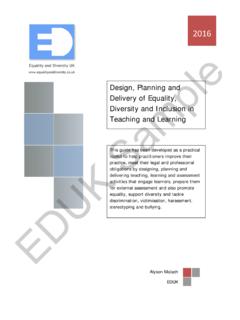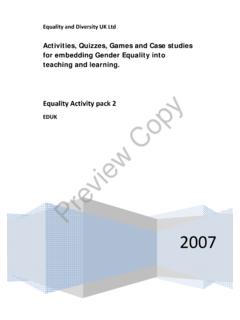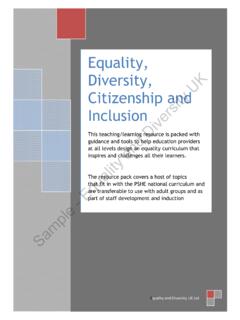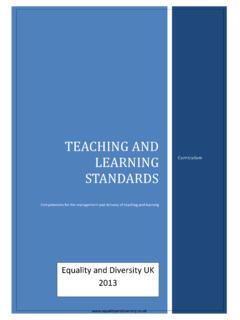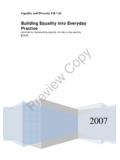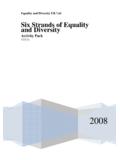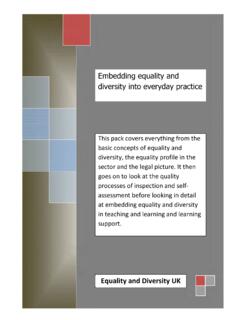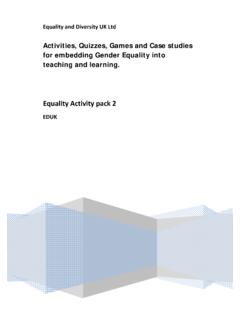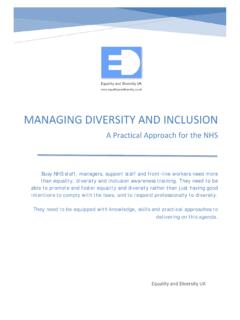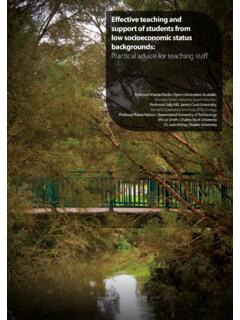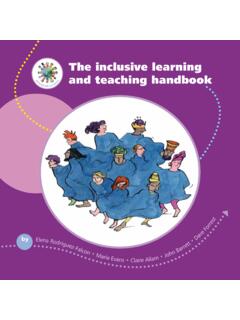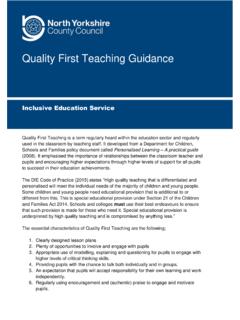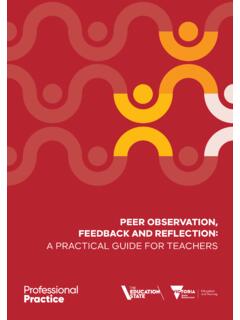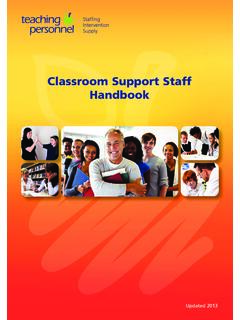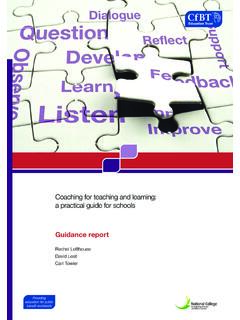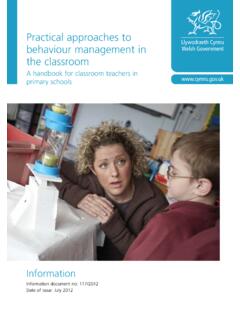Transcription of EDI Design Planning Delivery Teaching Learning
1 2016. e Design , Planning and pl Delivery of Equality, Diversity and Inclusion in m Teaching and Learning Sa This guide has been developed as a practical toolkit to help practitioners improve their practice, meet their legal and professional obligations by designing, Planning and delivering Teaching , Learning and assessment activities that engage learners, prepare them K. for external assessment and also promote equality, support diversity and tackle discrimination, victimisation, harassment, U. stereotyping and bullying. ED. Alyson Malach EDUK. Contents 1 About this guide 3. 2 Why is equality and diversity important? 6. What we are required to do 6. The challenge 8. e 3 Inclusive Teaching and Learning 10. What do we mean by inclusive Teaching and Learning ? 10. pl Preparing yourself for inclusive Teaching and Learning 10. 4 Designing your programme 12. m 5 Planning your sessions 16. 6 Delivering your sessions 21.
2 7 Evidencing your EDI 25. Sa Measuring the impact of your EDI activities 25. How can you use your SoW and lesson plans to evidence EDI? 26. Examples of schemes of work that embed EDI 28. Tips for integrating EDI into your SoW and lesson plan documentation 34. 8 Being more inclusive in what you say 36. K. The problems with language 36. Issues with language 36. U. 9 Being more inclusive in what you do 41. Showing respect for diversity 41. Everyday good practice 42. ED. 10 practical tips for creating accessible Learning materials 46. Tips for improving the readability of your materials 46. Tips for using PowerPoint and interactive whiteboards 49. Tips for producing accessible handouts 52. 11 practical tips for creating accessible physical environments 56. 12 practical tips for challenging discriminatory behaviour 59. 1. Activities 64. The consequences of NOT embedding EDI in Teaching and Learning 65. Make sure you are not fuelling inequality in your subject area 67.
3 Know your learners 69. Seek out opportunities for incorporating EDI 74. Where are you now? 76. e Building EDI into a scheme of work 80. Raising your equality and diversity awareness 90. pl Make written materials accessible 93. Challenging in a non-confrontational way 95. m Sa K. U. ED. 2. 1. About this guide Equality and diversity not that old chestnut again! e It's hard enough to fit everything in without pl finding time for equality and diversity as well! m Teaching E&D isn't my job! Sa I do treat everyone equally! I don't know why they said there was no evidence of E&D in my K. lesson plan/SoW. I look at it and do things U. differently if I need to! ED. There aren't any opportunities for building E&D into my subject! 3. But what if you could make a few changes that would: engage learners by showing how what you are Teaching can be applied to solve real life problems help them develop personal and social skills that will be useful to them in the workplace and in social situations make it easier for students to learn and keep up in class e reduce tension and help learner to get on better with each other pl improve learner outcomes demonstrate to Ofsted inspectors that you promote equality and diversity through Teaching and Learning m This guide has been developed as a practical toolkit to help practitioners improve their practice, meet their legal and professional obligations by designing, Planning Sa and delivering Teaching , Learning and assessment activities that engage learners, prepare them for external assessment and also promote equality, support diversity and tackle discrimination, victimisation, harassment, stereotyping and bullying.
4 It aims to: explain your legal and professional obligations to promote equality, tackle discrimination and foster good relations as set out in the Equality Act 2010. K. and by Ofsted's Common Inspection Framework for Further Education and Skills and its accompanying guidance help you to prepare yourself for the task U. offer practical advice on designing your programme and Planning and delivering sessions that engage and are accessible to all learners show you how you can evidence your work on equality, diversity and inclusion ED. (EDI) in your scheme of work (SoW) and lesson Planning documentation suggest simple strategies for supporting equality and diversity in everyday situations help you to create accessible Learning materials and physical environments. offer practical advice on dealing with challenging situations in an effective way The information in the guide is supplemented by a range of activities to help you test your understanding and apply your Learning to the classroom, tutorial or induction process.
5 4. Many of the activities will kick start the preliminary thinking, Planning and awareness raising processes you will need to embed equality and diversity into your area of work. The following icons are used to help you quickly identify useful tips and sources of more information. practical tips for making sure practical tips for making sure e that everyone can content appears relevant to all participate learners practical tips for fostering practical tips for checking the pl good relations quality of your EDI activities Signpost to further Signpost to an activity to help information develop skills or plan action m Sa K. U. ED. 5. 2. Why is equality and diversity important? There are many good reasons for building equality, diversity and inclusion into Design , Planning and Delivery of Teaching and Learning , and strong moral. Legal and business cases can be made to support the idea. However, for many Learning providers it is the need to meet Ofsted requirements that kick starts the process.
6 E What we are required to do Organisations such as further education and skills providers are subject to the public pl sector equality duty (PSED) set out in the Equality Act 2010. They must, in the exercise of their functions, have due regard to the need to: eliminate unlawful discrimination, harassment and victimisation and other m conduct prohibited by the Act advance equality of opportunity between people who share a protected characteristic and those who do not foster good relations between people who share a protected characteristic Sa and those who do not. The Act explains that having due regard for advancing equality involves: removing or minimising disadvantages suffered by people due to their protected characteristics taking steps to meet the needs of people from protected groups where these K. are different from the needs of other people encouraging people from protected groups to participate in public life or in other activities where their participation is disproportionately low.
7 U. In judging the quality of Teaching , Learning and assessment, one of the criteria that inspectors must evaluate is the extent to which equality and diversity are promoted through Teaching and Learning . ED. To make this judgement, inspectors will evaluate how well: Teaching , Learning and assessment promote equality, support diversity and tackle discrimination, victimisation, harassment, stereotyping or bullying (cyber-bullying and prejudice-based bullying related to special educational need, sexual orientation, sex, race, religion and belief, gender reassignment or disability). staff use materials and Teaching methods that foster good relations and are sensitive to and promote equality of opportunity 6. 3. Inclusive Teaching and Learning What do we mean by inclusive Teaching and Learning ? Inclusive Teaching and Learning means enabling all learners, regardless of their gender, gender identity, culture, race, religion or belief, sexual orientation, disability or other circumstances, to access the Learning environment, information and resources and to fully participate in Learning activities that have been designed with e them in mind.
8 Inclusive Teaching and Learning is about weaving equality, diversity and inclusion pl (EDI) for all into your course Design , Planning and Delivery . It values the diversity of all learners and aims to draw on their skills, knowledge, experiences and understanding to enhance the Learning experience. m Inclusive practice relies on a range of differentiation strategies which could include some of the following: additional classroom tutor support (or Learning support assistant). Sa adapted or specific resources peer support varied presentation content selection reducing or increasing time for activities or expected output. K. Preparing yourself for inclusive Teaching and Learning U. An important part of inclusive Teaching and Learning that is often overlooked is being aware of your own assumptions and biases, and doing regular reality checks' on your perceptions to ensure that you really behave in a fairly and inclusive way to all learners.
9 ED. We all make assumptions about people but this can lead to: prejudice making your mind up about someone before getting to know them stereotyping assuming that everyone with similar characteristics is the same discrimination treating people differently because of your beliefs 10. 4. Designing your programme Most of us do not have the luxury of a free rein to Design a course from scratch. Usually we are designing a courses that lead to externally assessed or verified nationally recognised qualifications where the awarding body specifies the course content and assessable Learning outcomes. Many also provide outline Learning plans and suggest assignments to fulfil these criteria. However, you often have the opportunity to refine the context and choose the examples you use to aid e understanding. This is where you may find opportunities to build equality and diversity into the curriculum. pl Know your learners You may not know who your learners are yet.
10 If this is the case and the m course has run before, you may have an idea of the demographic and be able to plan accordingly, taking aboard any feedback you have received with common themes from groups of learners (for example girls on STEM courses or learners from different ethnic groups). If your organisation has been Sa working on attracting learners from groups previously under-represented in your subject area, you need to focus on making course content interesting, relevant, accessible and engaging to them. If your course is the next part of a multi-year course or learners are progressing from a lower level to a higher level course, you will be able to find out more about your learners and can Design your course accordingly. Use and contribute to shared learner profiles or build up your own profiles if K. these are not available. A simple profile would consist of the learner's name, the issue they face, how it impacts on their Learning and what action or support could make things easier for them.
